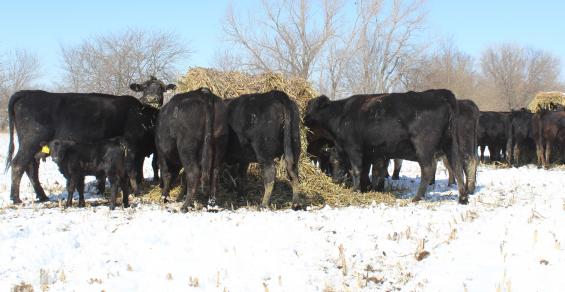Hay bale grazing is becoming a popular method of feeding cattle and improving soil health.
Baling grass hay is a summer chore that almost every cattle producer dreads. Every round that baler runs in the field, and every loaded mile that hay travels to storage, are time and resources that could be spent somewhere else on the farm. Then, in the winter, loading up hay bales from storage only to drive them back to grass paddocks for cow herds can be a muddy and just as time-consuming chore.
For one ranching couple near Wamego, Kan., the answer is to bring the cows to the bales instead.
A different way
Barb Downey and Joe Carpenter own and operate Downey Ranch Inc., raising registered and commercial Angus and SimAngus cattle on native grasses in the Flint Hills of Kansas. The couple has several goals when it comes to the ranch. They must be efficient with their labor, since both of their daughters are now grown and out of the house. They prefer easy handling techniques. And they’re trying to improve the soil health of their land.
A few years ago, Downey was running the baler — a chore she really doesn’t enjoy — and she was mulling over the time and fuel they spent on putting up brome hay and forage for their cow-calf herd.
“The whole idea is to just not spend money doing stuff you don’t have to do,” Downey says. “If you’ve ever moved bales, brought them home from the field, I find that the single most frustrating thing — because my mind is just constantly going, ‘How much time and money am I wasting doing this?’ It’s so inefficient.”
The couple had finished baling a field of sorghum-sudan forage when it started raining, and they were not able to get the bales moved out of the field before the crop was regrowing around the bales.
So, they decided to leave the bales in place and break the field into several different paddocks that autumn for cows to graze, two to three bales at a time.
And it worked. The cattle ate well, they reduced their time and fuel spent feeding hay — and even better, the soil started to improve where they were bale grazing.
Maybe even more startling was when they calculated their savings.
“If those bales are in a bale yard, and we have to deliver them, it costs $1 per head per day,” Downey says. Figure 400 head and that’s roughly $400 per day they’re saving, she adds.
Bale grazing
Since that first fall, Downey and Carpenter have learned and adapted their bale grazing techniques to their specific needs.
The couple prefers to bale-graze in farm fields or brome fields. They’ll rotate farm fields into summer crops and cover crops after the bales are grazed. They never bale-graze on native grass range, preferring grasses that spread by rhizomes. As Downey explains, you do get some grass kill under the bale — but wait until the next growing season, and you’ll see that the brome around the bale has been fertilized by the grazing cows and spreads aggressively to fill the space.
“We don’t see it in the second year, other than noticeably green and lush circles from the mulch and the extra nutrients,” she says. And you can certainly see in a drought year where the circles from the bales were — they’re lusher than the rest of the surrounding ground.
Some specifics:
Stocking rate. The couple can graze 100 to 400 cow-calf pairs in the system, moving every few days to the next paddock, depending on the size of the field. They fence off two days of feed at a time to manage cattle intake.
Electric fence. The bale grazing system requires breaking out fields into smaller paddocks using electric fence. Carpenter uses a golf club bag to carry fence posts, and a cordless drill with an attachment to spool and unspool electric fence quickly by himself.
Water. Every paddock has access to water through either streams, adjacent ponds or developed water, Carpenter says.
Moving cattle. The couple sets up two to three paddocks at a time. When they open up a new paddock they don’t fence behind the herd. That way, the herd has access to previously grazed paddocks. The cattle have gotten used to being moved quietly, resulting in less time spent handling stock at other times of the season.
Soil health. Raising the organic matter content in their soil is putting money in the bank for the ranch. And this method leaves nutrients on the field, where grazing ruminants complete the whole soil health system. Their organic matter has increased in their soil, and they have reduced or cut altogether the amount of phosphorus, potassium or sulfur they apply to their fields.
Compaction. It’s a non-issue, Downey says. They’ve no-tilled soybeans into fields that were bale-grazed in wet years, with pock marks from cow hooves visible. They raised 62-bushel soybeans. The soil, they say, is much more resilient.
Twine. They’ve switched to sisal twine for bale grazing. They don’t recommend using plastic twine or netwrap for this system, since it’s not biodegradable and can harm cattle if ingested. With sisal, they don’t have as much worry about cattle ingesting the twine, and it breaks down in the hay mat left on the field.
Downey and Carpenter stress that bale grazing may not be for everyone. But in a year like this one, when fertilizer inputs are costly and hard to source, it can pay to keep nutrients on the land. They use less fuel just moving bales up and down the road, and that’s also less wear and tear on equipment. And they’re seeing much more resilient soils. All by bringing the cows to the bales instead of taking the bales to the cows.





